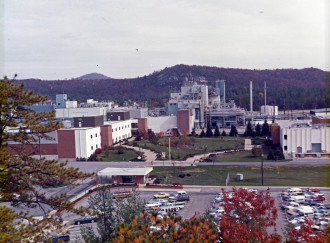The DuPont Forest Festival, scheduled for Saturday, Sept. 22, has been a long time in the making. Hosted by the Friends of DuPont Forest to coincide with National Public Lands Day, the event is the first-ever big celebration of land that’s been under state protection since 1997. Guided tours, educational lectures and hands-on demonstrations will give outdoor enthusiasts of all stripes a chance to learn more about the forest’s over 10,000 acres.
The previous lack of a coming-out party hasn’t stopped DuPont State Recreational Forest from becoming a popular destination for both locals and tourists. Attracted in large part by a trio of easily accessible waterfalls — High Falls, Triple Falls and Hooker Falls — roughly 588,000 visitors visited DSRF during the last fiscal year. An informal survey of license plates in the High Falls parking lot often finds cars from Florida, Kentucky, Ohio, Minnesota and even Ontario.
But people have been drawn to the area since well before DSRF was designated as public land. Micajah Thomas, the namesake of the forest’s Micajah Trail, lived and farmed there as early as 1799, and his family’s graves lie along its Thomas Cemetery Road. The Moore and Hooker families operated a grist mill in the Hooker Falls area in the 1880s.
The tenant with the greatest impact on the region, however, was DSRF’s namesake: the chemical conglomerate DuPont. The company’s initial purchase of land for a silicon manufacturing plant in Cedar Mountain proved the beginning of a journey that would preserve one of Western North Carolina’s most treasured natural places for the future.
Land of the waterfalls
The groundwork for DuPont’s arrival in the region was laid even further in the past, according to Henderson County resident Chan Hubbard. Now 83 years old, Hubbard was DuPont’s first employee at the site. The company recruited him to help build the plant based on his military training in explosives and experience working on local roads.
“In 1929, the land of the waterfalls was surveyed for hydroelectric power,” Hubbard explains. “Dupont knew about the survey, and that’s what attracted them to the area. They needed good water and air for their silicon operations.”

DuPont snapped up thousands of forested acres to ensure clean surroundings for its facility. The company’s first purchases took place in 1956, with the primary sellers being the Asheville-based Frank Coxe family and the A.H. Guion Company of Charlotte. The plant itself went up in 1958; DuPont later bought an additional 1,400 acres from the Summit Camps, operated until 1983 by Ben Cart.
After DuPont opened its factory, Hubbard rotated into security and became the liaison between management and nonexempt workers. He says it was “a pleasure” to work for the company, a theme that pops up again and again in accounts from DuPont employees and their families.
Vicki Sprouse, the daughter of a DuPont industrial mechanic, recalls long summer days spent at Lake DERA (DuPont Employees Recreational Area), which is now located in DSRF boundaries but currently off-limits to the public. “It was just about the most fun a kid could have — especially when they added the paddle boats!” she says. “My mom would pack us a picnic lunch, and we would stay at the lake until my dad got off work at 4:30, and he would stop by to see what we were up to.”
DuPont families and their guests could camp, fish and hike on the property at will, needing only to fill out a form with company security. The firm also hosted annual Christmas parties and summer picnics, the latter vividly remembered by Sprouse for free cotton candy and snow cones. “Folks who were fortunate enough to get a job at DuPont hardly ever quit, because the pay was so good, and the benefits very generous,” she adds.
A new beginning
Yet the good times couldn’t last forever. In 1995, DuPont announced that it was leaving the area and selling the plant, then producing X-ray film for medical purposes, to Sterling Diagnostics Imaging. Over three-quarters of the company’s land would go up for sale as well, with rumors that the forest would be slated for real estate development and a landfill.
The news came as a heavy blow to Jeff Jennings. The process development engineer had joined DuPont in 1985 and rotated through the company’s locations in South Carolina, Tennessee and Delaware before arriving at the WNC plant in 1991. “I fell in love with the area. I was stunned by the beauty,” he remembers.

Jennings had gained a deep appreciation for the region after a trip to Germany shifted his environmental consciousness. “They had a high priority on recycling, energy conservation and quality of life through free time in nature,” he says. “I came to see our lack of public access for walking and biking as a type of poverty, even if not recognized as such.”
By 1994, Jennings had become the president of ECO, the Environmental and Conservation Organization, now a part of local nonprofit MountainTrue. On learning the news of DuPont’s departure, he established himself as a bridge between his employer and the environmental community. He first called the DuPont Land Legacy department at the company’s headquarters in Wilmington, Delaware — “the group that gives land away,” he explains — followed by the Carolina Mountain Land Conservancy, now Conserving Carolina.
Chuck McGrady, then president of CMLC and now a state representative for Henderson County, in turn reached out to Rex Boner of the Conservation Fund, a national conservation funding agency. He encouraged Boner and Jennings to work together, and Boner visited the property soon after. “Nine months later, the Conservation Fund bought the land from DuPont: 7,600 acres for $2.2 million,” Jennings recalls. Although the land’s value on the open real estate market wasn’t assessed publicly, the price was regarded as practically a donation.
Completing the puzzle
The Conservation Fund transferred its purchase to the state in 1997, but nearly 2,700 acres of DuPont’s tract still remained in private hands — including land surrounding several of the forest’s iconic waterfalls. “In a way, the largest piece of the property from Dupont was the easiest,” says McGrady.
In 1999, Sterling Diagnostics Imaging resold the plant itself and 476 acres to the Agfa-Gevaert Group, splitting off the remaining 2,200 acres to South Carolina developer Jim Anthony, who planned to build upscale homes throughout the property. Those plans raised the attention of Jennings and resident Aleen Steinberg. The pair proceeded to form the nonprofit Friends of the Falls group and launch a massive public campaign to preserve the land.
“Republicans, Democrats, mountain bikers, equestrians, hikers and conservationists all joined hands in their beliefs,” Steinberg recalls. Governor Jim Hunt’s office was swamped by roughly 4,300 letters, cards and emails on the topic, the vast majority in favor adding the land to the state forest, and the Friends of the Falls took out advertisements throughout the state. After months of pressure, Hunt condemned the property to bring it under state control.
The final piece of land around the factory, known as the “donut hole” of the forest, traded hands back to DuPont after Agfa closed up shop in 2002. The corporation took responsibility for remediating the water and soil by removing thousands of pounds of X-ray film waste, a process that continued even after DuPont’s donation of the land to the state in 2016. “Public use could be a few years away,” says Jason Guidry, DSRF forest supervisor.
Kent Wilcox, a retired professor from Wisconsin now living in Cedar Mountain and past president of Friends of DuPont Forest, has a front-row seat to the effort. “I may be naive, but I think the DuPont Corporation is trying to do the right thing with this cleanup,” he says. Once the donut hole is deemed safe, it will become an integral part of the land’s recreational opportunities.
What might have been
Some development has still taken place at DSRF: Permanent bathrooms are under construction at the Hooker Falls parking lot, while a visitor center named for Steinberg and a pedestrian bridge across the Little River both opened in 2013. Nineteen full-time employees now staff the forest instead of the informal committee that oversaw its early years with the Conservation Fund. But the land would likely have taken a much different path if DuPont hadn’t come to the area over 60 years ago.
“I imagine that the land would look a lot like much of the other mountainous land in Transylvania County,” Jennings says. “Look at the aerial photos of the land of waterfalls, with lots of private homes and developments and the occasional farm near the waterfalls.”
Bill Thomas, a retired DuPont research engineer and past president of the North Carolina Sierra Club, sees “summer camps, trailer parks and housing.” He imagines developments such as Sherwood Forest and Connestee Falls, both in Transylvania County, which respectively cover 1,000 and 3,900 acres.
Now, however, DSRF fits the rallying cry that the Friends of the Falls embraced in their appeal to the state. “The land belonged to the people,” Steinberg says.




Before you comment
The comments section is here to provide a platform for civil dialogue on the issues we face together as a local community. Xpress is committed to offering this platform for all voices, but when the tone of the discussion gets nasty or strays off topic, we believe many people choose not to participate. Xpress editors are determined to moderate comments to ensure a constructive interchange is maintained. All comments judged not to be in keeping with the spirit of civil discourse will be removed and repeat violators will be banned. See here for our terms of service. Thank you for being part of this effort to promote respectful discussion.